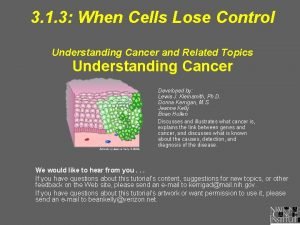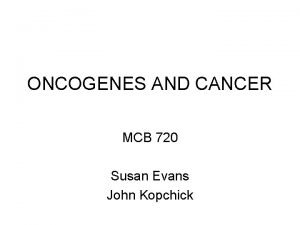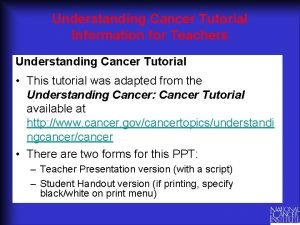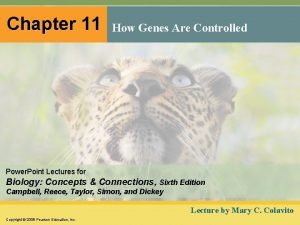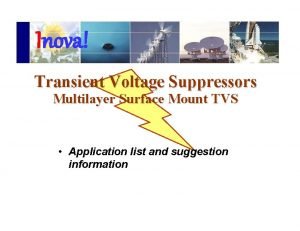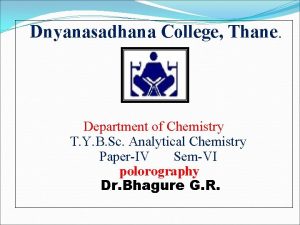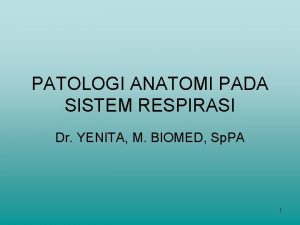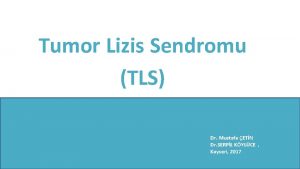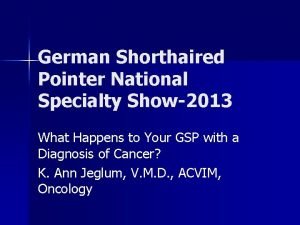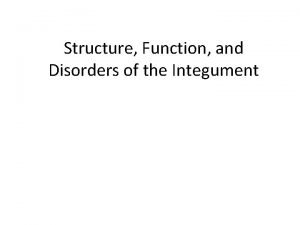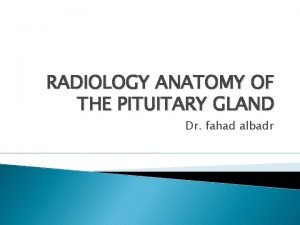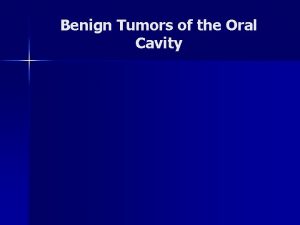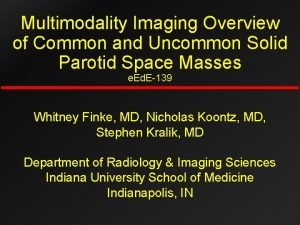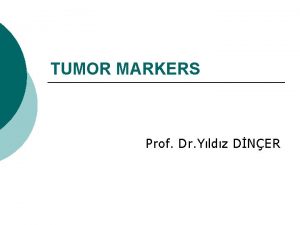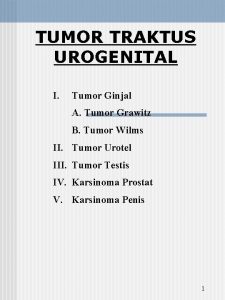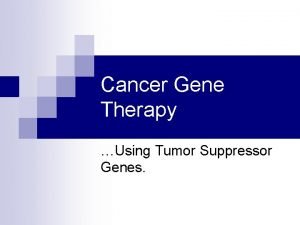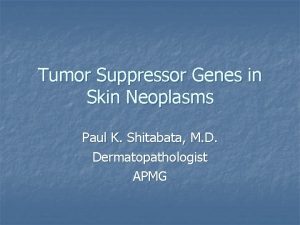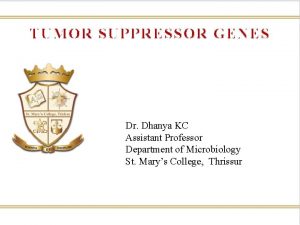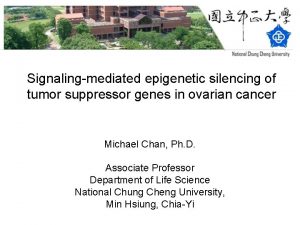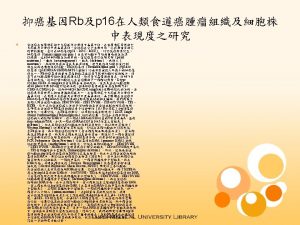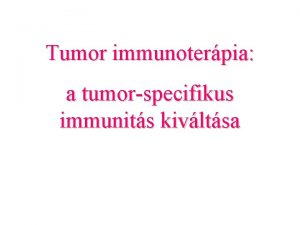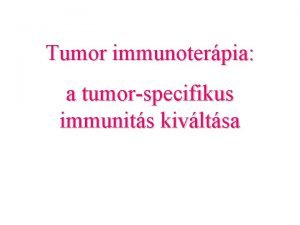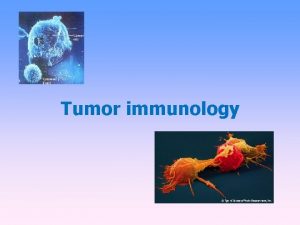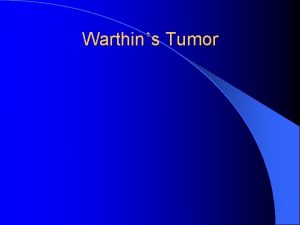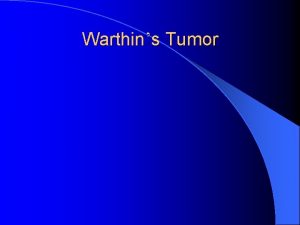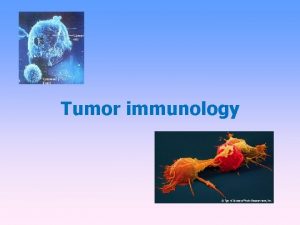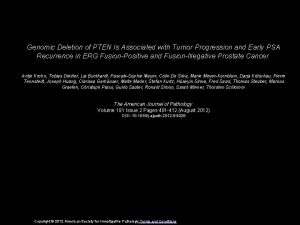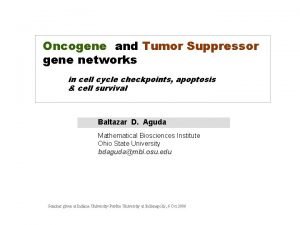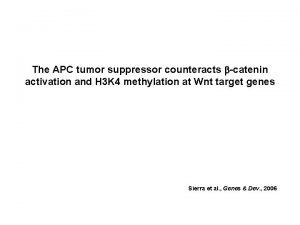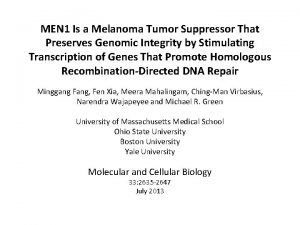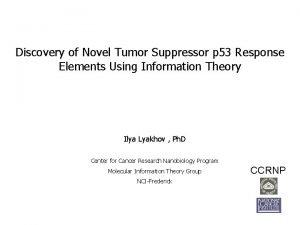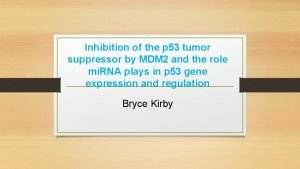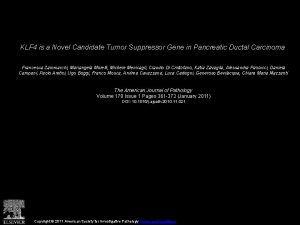Tumor Suppressor Genes p 53 PTEN G Mathan




























- Slides: 28

Tumor Suppressor Genes p 53 &PTEN G. Mathan Ph. D Assistant Professor

Characteristics of Cancer Activated protooncogene Inactivated tumour suppressor gene For cancer: two classes of cellular genes are targets for mutations • PROTO-ONCOGENES • TUMOUR SUPRESSOR GENES


Tumour suppressor genes Act as a brake for cell division “GUARDIAN OF THE GENOME” Mutation in tumour suppressor genes = brakes don’t work, or there is an accumulations of mutations (DNA repair enzymes) The mutated gene product is not functional = NULL ALLELE

Discovery of p 53 The discovery in 1979 of the p 53 protein was the culmination of two types of studies involving a virologic approach and a serologic approach. 53 -k. Da protein was overexpressed in a wide variety of murine SV 40 transformed cells, but also in uninfected embryonic carcinoma cells. A partial peptide map from this 53 -k. Da protein was identical among the different cell lines, but was clearly different from the peptide map of SV 40 large-T antigen (Kress et al. 1979; Linzer and Levine 1979). It was then postulated that SV 40 infection or transformation of mouse cells stimulates the synthesis or stability of a cellular 53 -k. Da protein.

Discovery of p 53 §methylcholanthrene-induced tumor cell line such as Meth. A was directed toward the p 53 protein. §Later, it was found that animals bearing several types of tumors elicited an immune response specific for p 53 (Kress et al. 1979; Melero et al. 1979; Rotter et al. 1980). § In 1982, Crawford et al. first described antibodies against human p 53 protein in 9% of breast cancer patient sera. No significant clinical correlation was reported, and at that time no information was available concerning mutations of the p 53 gene.

p 53 gene The TP 53 gene is localized on chromosome 17 (short arm, 17 p 13), a region that is frequently deleted in human cancer. .

Organization of the human p 53 gene Human p 53 is 393 amino acids long and has three domains: • An N-terminal transcription-activation domain (TAD), which activates transcription factors • A central DNA-binding core domain (DBD). Contains zinc molecules and arginine amino acid residues. • C-terminal homo-oligomerisation domain (OD). Tetramerization greatly increases the activity of p 53 in vivo. • 11 exons (blue) coding for a 2. 2 Kb m. RNA. Translation begin in exon 2. Sizes of exons and introns are shown in bp.

Examples of tumour suppressor genes include: • RB 1 - retinoblastoma susceptibility gene • WT 1 - Wilm's tumour gene • NF 1 - neurofibromatosis type 1 gene • NF 2 - neurofibromatosis type 2 gene • DCC - involved in colorectal cancer • BRCA 1, BRCA 2 - involved in breast cancer

Genetic Mutations That Can Cause Cancer Tumor Suppressor Genes • Genes that inhibit cell division are inactivated. – Mutation in a gene that halts the cell cycle in G 1 causes retinoblastoma. – Mutation in p 53, a gene that promotes apoptosis if a cell has damaged DNA, leads to a variety of cancers. – Mutation in BRCA 1, involved in tumor suppression and DNA repair, leads to inherited breast cancer.

Rb = product of Retinoblastoma gene, inhibits action of E 2 F until chemically modified In Normal Cells, the Rb Gene Product Controls the G 1 S Transition E 2 F = transcription factor required to activate genes for DNA synthesis CDK-cyclin (intracellular signal) modifies Rb so the E 2 F can mediate the G 1 S transition People prone to retinoblastoma have one mutated copy of the Rb gene (Rb-) and one normal copy (Rb+). Conversion of the Rb+ copy to Rb- by mutation leads to uncontrolled growth of retinal cells.

Li-Fraumeni syndrome. • THE p 53 GENE like the Rb gene, is a tumor suppressor gene, i. e. , its activity stops the formation of tumors. • If a person inherits only one functional copy of the p 53 gene from their parents, they are predisposed to cancer and usually develop several independent tumors in a variety of tissues in early adulthood. This condition is rare, and is known as Li-Fraumeni syndrome.

p 53 = transcription factor that causes p 21 to be produced In Normal Cells, the p 53 Gene Product Acts at the G 1 S Checkpoint Preventing Entry Into S Phase If DNA Is Damaged p 21 inhibits intracellular signals that would activate EF 2 Cells with damaged DNA do not pass the G 1 S checkpoint In cancer cells the mutated p 53 gene product no longer stimulates p 21 production. Cells will pass the G 1 S checkpoint even when chromosomal damage exists.

In Normal Cells, the p 53 Gene Product Stimulates Apoptosis If DNA Damage Cannot Be Repaired p 53 gives an internal signal for apoptosis In cancer cells, a mutated p 53 gene product no longer initiates selfdestruction. Cells with damaged DNA can divide and more DNA damage can be accumulated. p 53 is the most frequently mutated of all known cancer-causing genes, contributing to many types of cancer.

p 53 network Vogelstein, B. , Lane, D. P. , and Levine, A. J. (2000). Surfing the p 53 network. Nature 408: 307 -310.

Carcinogens can Damage the p 53 Gene Benzo(a)pyrene, a chemical produced by internal combusion engines and thus common in the environment, is not itself mutagenic. In the mammalian liver, benzo(a)pyrene is metabolized to diol epoxide, which binds covalently to guanine bases, preventing proper base pairing with cytosine bases. Bulky Addition Products such as diol epoxide or Aflatoxin B 1 may result in depurination mutagenesis and are known to be carcinogens. Another factor that influences p 53 mutation is Caused by exposure to Ultra Violet Radiation

§The E 6 viral protein expressed by HPV specifically binds to the p 53 protein and induces its degradation (Scheffner et al. , 1990). § p 53 mutations in cervical cancer is VERY RARE (Crook et al. , 1992). §p 53 inactivation by a viral protein has not been formally demonstrated in other human cancers associated with viral infection, such as HCC (associated with HBV)

The mdm 2 protein regulates the stability of the p 53 protein by ubiquitination and transport towards the proteasome (Iwakuma and Lozano, 2003; Moll and Petrenko, 2003). Abnormal accumulation of the mdm 2 protein is observed in many tumours, especially sarcomas (Onel and Cordon-Cardo, 2004). These tumours would be expected to no longer express p 53, the opposite situation is generally observed, with a large number of tumours overexpressing both p 53 and mdm 2. Suggesting that this situation could be due to an oncogenic activity of mdm 2 independent of p 53.

PTEN mutations AKT Alterations AKT kinase phosphorylates mdm 2 protein and induces its migration into the nucleus where it binds and ubiquinates p 53. Upon growth factor activation, mdm 2 activation through AKT activation ensure proper cell growth. PTEN, a p 53 regulated gene, down regulate the AKT pathway. PTEN deletion leads to an increase of AKT activity, an increase of nuclear mdm 2 and impairs p 53 response Although no mutation of AKT has been found in human cancer, constitutive activation of its kinase activity has been observed via deregulation of the upstream pathway

Upstream signaling DNA damage induced by gamma radiation INDUCED activated ATM phosphorylates p 53 on Ser 15, CHK 2 on Thr 68, and murine double minute 2 (mdm 2) on Ser 395. Activated CHK 2 phosphorylates p 53 on Ser 20. Together, these phosphorylations interfere with p 53 binding to MDM 2, leading to stabilization and activation of p 53. Mutations of ATM in T-cell leukaemia impair the p 53 response after gamma radiation Mutations of CHK 2 are found in Li. Fraumeni like families.

P 53 mutations ØMutations that deactivate p 53 in cancer usually occur in the DBD. ØMost of these mutations destroy the ability of the protein to bind to its target DNA sequences, and prevent transcriptional activation of these genes. ØMutations in the DBD are recessive loss-of-function mutations. ØMolecules of p 53 with mutations in the homo-oligomerisation domain (OD) dimerise with wild-type p 53, and prevent them from activating transcription. Therefore OD mutations have a dominant negative effect on the function of p 53.

knockout model (p 53 KO) Endogenous p 53 gene is either totally or partially deleted either in whole body or in specific tissue. A null mutation was introduced into the gene by homologous recombination in murine embryonic stem cells. Mice homozygous for the null allele appear normal but are prone to the spontaneous development of a variety of neoplasms by 6 months of age. (Donehower LA et. al. , 1992, Nature)

mouse p 53 m Mice with a deletion mutation in the first six exons of the p 53 gene that express a truncated RNA capable of encoding a carboxy-terminal p 53 fragment. P 53 m exon 1 to 6 deletion /Aging phenotype

Major enzymatic function of PTEN is a tumor suppressor gene PTEN opposes action of PI 3 K by dephosphorylation Yamada K M , Araki M J Cell Sci 2001; 114: 2375 -2382

PTEN Pathway SIGMA-ALDRICH PTEN also inhibits growth factor (GF)-induced Shc phosphorylation and suppresses the MAP kinase signaling pathway. PTEN interacts directly with FAK and is able to dephosphorylate activated FAK. PTEN-induced downregulation of p 130 CAS through FAK results in inhibition of cell migration and spreading. The activation of Akt/PKB is regulated by the phosphorylation of Akt on Thr 308 and Ser 473 by phosphoinositide-dependent kinase (PDK) and integrin-linked kinase (ILK), respectively.

Reported sites of action of PTEN. Yamada K M , Araki M J Cell Sci 2001; 114: 2375 -2382

Thanks for your Attention

Acknowledgement v The Presentation is being used for educational and non commercial purpose v Thanks are due to all those original contributors and entities whose pictures used for making this presentation.
 Cancer prefix
Cancer prefix Difference between proto oncogene and oncogene
Difference between proto oncogene and oncogene Tumor suppressor genes
Tumor suppressor genes Tumor suppressor gene
Tumor suppressor gene Linked genes and unlinked genes
Linked genes and unlinked genes Glomerulus
Glomerulus Polygenic inheritance
Polygenic inheritance Surface mount transient voltage suppressor
Surface mount transient voltage suppressor Colleg xnx
Colleg xnx Tumor immunology
Tumor immunology Tumor lateral de cuello
Tumor lateral de cuello Borrmann classification
Borrmann classification Carcinoma
Carcinoma Dr serpil köylüce
Dr serpil köylüce Mast cell tumor german shorthaired pointer
Mast cell tumor german shorthaired pointer Inervacion sensitiva del paladar blando
Inervacion sensitiva del paladar blando Nursing diagnosis of adrenal tumor
Nursing diagnosis of adrenal tumor Disembriyoplastik nöroepitelyal tümör
Disembriyoplastik nöroepitelyal tümör Tumor
Tumor Pituitary venous drainage
Pituitary venous drainage Rugger jersey sign in osteopetrosis
Rugger jersey sign in osteopetrosis Benign tumor definition
Benign tumor definition Primitive neuroectodermal tumor
Primitive neuroectodermal tumor Warthin's tumor ultrasound images
Warthin's tumor ultrasound images Penanda tumor ca 19-9
Penanda tumor ca 19-9 Malignitetssuspekte
Malignitetssuspekte Grawitzův tumor ledvin prognóza
Grawitzův tumor ledvin prognóza Klatskin tumor
Klatskin tumor Trias tumor ginjal
Trias tumor ginjal
